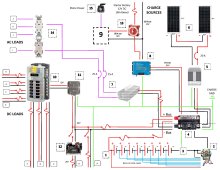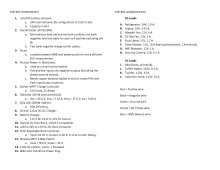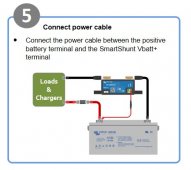Hello all,
I've mostly finished designing my camper van solar system and would appreciate some feedback. See the attached schematic and legend. This is my first build.
Any general feedback over any topic is welcome. I have a few specific questions as well:
1. Will the Epever 20A max controller work for my system or should I bump it up to 30A? Based on the data from Richsolar and my setup, it looks like the current could not exceed something like 18A on the output from the controller, but I'm not sure if panel voltage spikes on cold mornings would make it shoot up over 20A, or anything else. Just not super confident about that.
2. I haven't selected a shunt yet (component 3). Any tips on what to look for? I want one for accurate SOC measurement, as I've heard the Overkill BMS can be off. Not wanting to spring for the Victron SmartShunt.
3. I still haven't selected a battery charger (component 9). The Xijia inverter is not a charger, so if I want shore power, I'll need one of these. Can I use any random 120 AC input to 12V output charger? There are plenty of automotive ones for sale designed for AGM, and I wouldn't use one of those directly on my LiFePO4 bank, but since I have the Victron 12/24 in-between can I use any old charger? I'll seldom be hooked up to shore, so this component won't see much use.
4. I'm not sure about grounding protocols. Just ground anything with a metal case, correct? And what about AC grounding? Should I go with a GFCI or a standard outlet?
5. I haven't nailed down fuses, breakers, or wire sizes yet. Do I need a fuse between the MPPT and the busbar? Or one between the Victron 12/24 and the busbar? Any tips on fuses/breakers are appreciated.
Thanks for any and all responses.
I've mostly finished designing my camper van solar system and would appreciate some feedback. See the attached schematic and legend. This is my first build.
Any general feedback over any topic is welcome. I have a few specific questions as well:
1. Will the Epever 20A max controller work for my system or should I bump it up to 30A? Based on the data from Richsolar and my setup, it looks like the current could not exceed something like 18A on the output from the controller, but I'm not sure if panel voltage spikes on cold mornings would make it shoot up over 20A, or anything else. Just not super confident about that.
2. I haven't selected a shunt yet (component 3). Any tips on what to look for? I want one for accurate SOC measurement, as I've heard the Overkill BMS can be off. Not wanting to spring for the Victron SmartShunt.
3. I still haven't selected a battery charger (component 9). The Xijia inverter is not a charger, so if I want shore power, I'll need one of these. Can I use any random 120 AC input to 12V output charger? There are plenty of automotive ones for sale designed for AGM, and I wouldn't use one of those directly on my LiFePO4 bank, but since I have the Victron 12/24 in-between can I use any old charger? I'll seldom be hooked up to shore, so this component won't see much use.
4. I'm not sure about grounding protocols. Just ground anything with a metal case, correct? And what about AC grounding? Should I go with a GFCI or a standard outlet?
5. I haven't nailed down fuses, breakers, or wire sizes yet. Do I need a fuse between the MPPT and the busbar? Or one between the Victron 12/24 and the busbar? Any tips on fuses/breakers are appreciated.
Thanks for any and all responses.








